Headlines
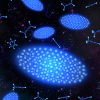 By using precise laser cooling and mass spectrometry to control quantum states, Heather Lewandowski (JILA, Physics) and her team have mimicked ion-neutral reactions similar to those in the interstellar medium, bringing scientists closer to understanding the chemical development of the cosmos.
By using precise laser cooling and mass spectrometry to control quantum states, Heather Lewandowski (JILA, Physics) and her team have mimicked ion-neutral reactions similar to those in the interstellar medium, bringing scientists closer to understanding the chemical development of the cosmos.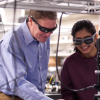 World Quantum Day, celebrated on April 14, is a worldwide initiative to promote the public understanding of quantum science. Learn more about the tight-knit quantum research community centered at CU Boulder, NIST, JILA and the surrounding Front Range area, including established companies and startups.
World Quantum Day, celebrated on April 14, is a worldwide initiative to promote the public understanding of quantum science. Learn more about the tight-knit quantum research community centered at CU Boulder, NIST, JILA and the surrounding Front Range area, including established companies and startups.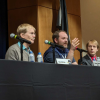 At CU Boulder's Conference on World Affairs, Dana Anderson (JILA, Electrical Engineering), the CSO of Infleqtion (previously ColdQuanta), joined forces with Corban Tillman-Dick, CEO and Founder of Maybell and chair of Elevate Quantum, to share his insights into the rapidly evolving quantum technology landscape.
At CU Boulder's Conference on World Affairs, Dana Anderson (JILA, Electrical Engineering), the CSO of Infleqtion (previously ColdQuanta), joined forces with Corban Tillman-Dick, CEO and Founder of Maybell and chair of Elevate Quantum, to share his insights into the rapidly evolving quantum technology landscape.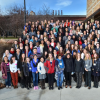 Building on efforts to promote diversity, equity and inclusion in physics, CU Boulder’s Department of Physics and JILA will host a Conference for Undergraduate Women and Gender Minorities in Physics (CU*iP) in January 2025. The conference will bring approximately 150 students from the Midwest region to Boulder.
Building on efforts to promote diversity, equity and inclusion in physics, CU Boulder’s Department of Physics and JILA will host a Conference for Undergraduate Women and Gender Minorities in Physics (CU*iP) in January 2025. The conference will bring approximately 150 students from the Midwest region to Boulder.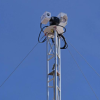 The Standoff Aerosol measUrement Remote Optical Network (SAURON)—designed to zoom in on hazardous aerosols that pose serious risks to humans—is based on a technology originally developed for quantum science by Professor Greg Rieker (Mechanical Engineering).
The Standoff Aerosol measUrement Remote Optical Network (SAURON)—designed to zoom in on hazardous aerosols that pose serious risks to humans—is based on a technology originally developed for quantum science by Professor Greg Rieker (Mechanical Engineering).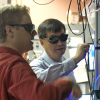 In the video, Jun Ye discusses how researchers at Q-SEnSE (an NSF Quantum Leap Challenge Institute) test some of the most advanced concepts of quantum physics and technology—including lasers, cold atoms, and quantum many-body physics—using state-of-the-art atomic clocks.
In the video, Jun Ye discusses how researchers at Q-SEnSE (an NSF Quantum Leap Challenge Institute) test some of the most advanced concepts of quantum physics and technology—including lasers, cold atoms, and quantum many-body physics—using state-of-the-art atomic clocks.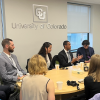 CU Boulder vice chancellor for research and innovation and dean of the institutes Massimo Ruzzene met with congressional and federal leaders in Washington, D.C. this month to advocate for robust funding, ensure effective coordination on ongoing projects, and proactively explore opportunities for future collaborations.
CU Boulder vice chancellor for research and innovation and dean of the institutes Massimo Ruzzene met with congressional and federal leaders in Washington, D.C. this month to advocate for robust funding, ensure effective coordination on ongoing projects, and proactively explore opportunities for future collaborations.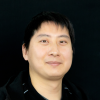 As a distinguished quantum information theorist, Professor Gao's work is at the cutting edge of exploring quantum computational advantages. His research delves into the capabilities and boundaries of contemporary quantum devices, quantum machine learning, and quantum optimization algorithms.
As a distinguished quantum information theorist, Professor Gao's work is at the cutting edge of exploring quantum computational advantages. His research delves into the capabilities and boundaries of contemporary quantum devices, quantum machine learning, and quantum optimization algorithms.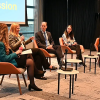 A study published in 2020 found that coding is the top skill needed in the quantum industry. “We need encourage our students to think broadly about entering the quantum industry with different types of degree preparation,” said Professor Heather Lewandowski (Physics), faculty director of CUbit Education and Workforce.
A study published in 2020 found that coding is the top skill needed in the quantum industry. “We need encourage our students to think broadly about entering the quantum industry with different types of degree preparation,” said Professor Heather Lewandowski (Physics), faculty director of CUbit Education and Workforce.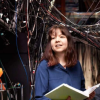 Jin’s groundbreaking work significantly impacted JILA and the wider field of physics, opening up new avenues for understanding quantum mechanics. Her career was distinguished by her innovative research in ultracold atomic gases, leading to the creation of a new form of matter, the fermionic condensate.
Jin’s groundbreaking work significantly impacted JILA and the wider field of physics, opening up new avenues for understanding quantum mechanics. Her career was distinguished by her innovative research in ultracold atomic gases, leading to the creation of a new form of matter, the fermionic condensate.

